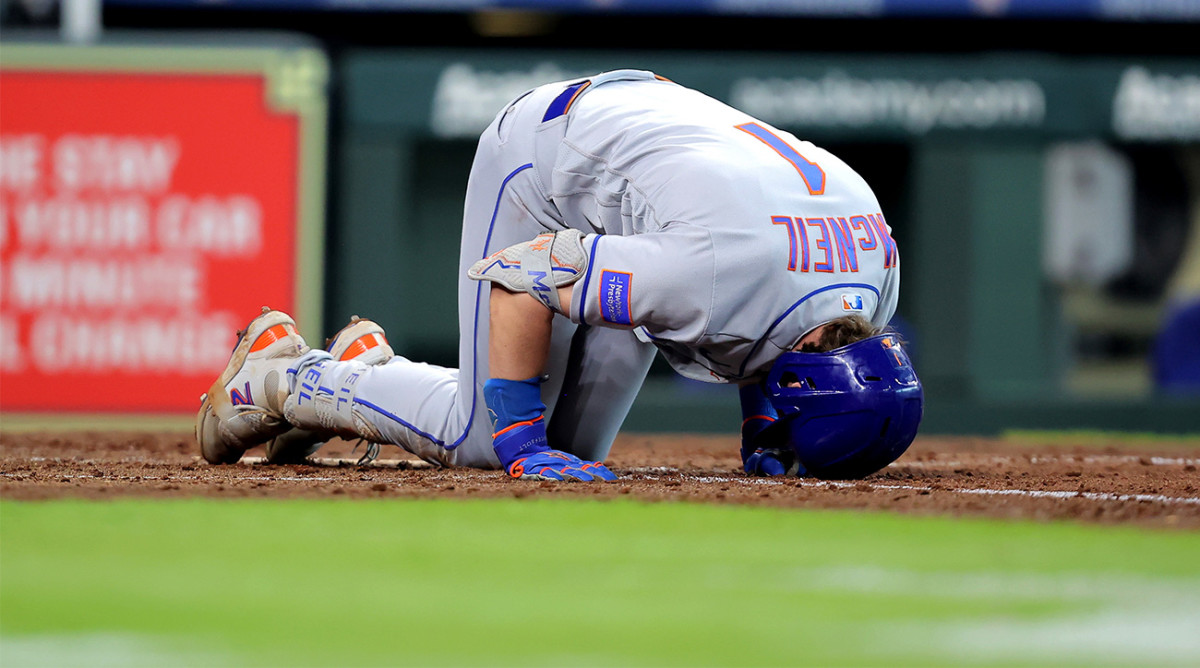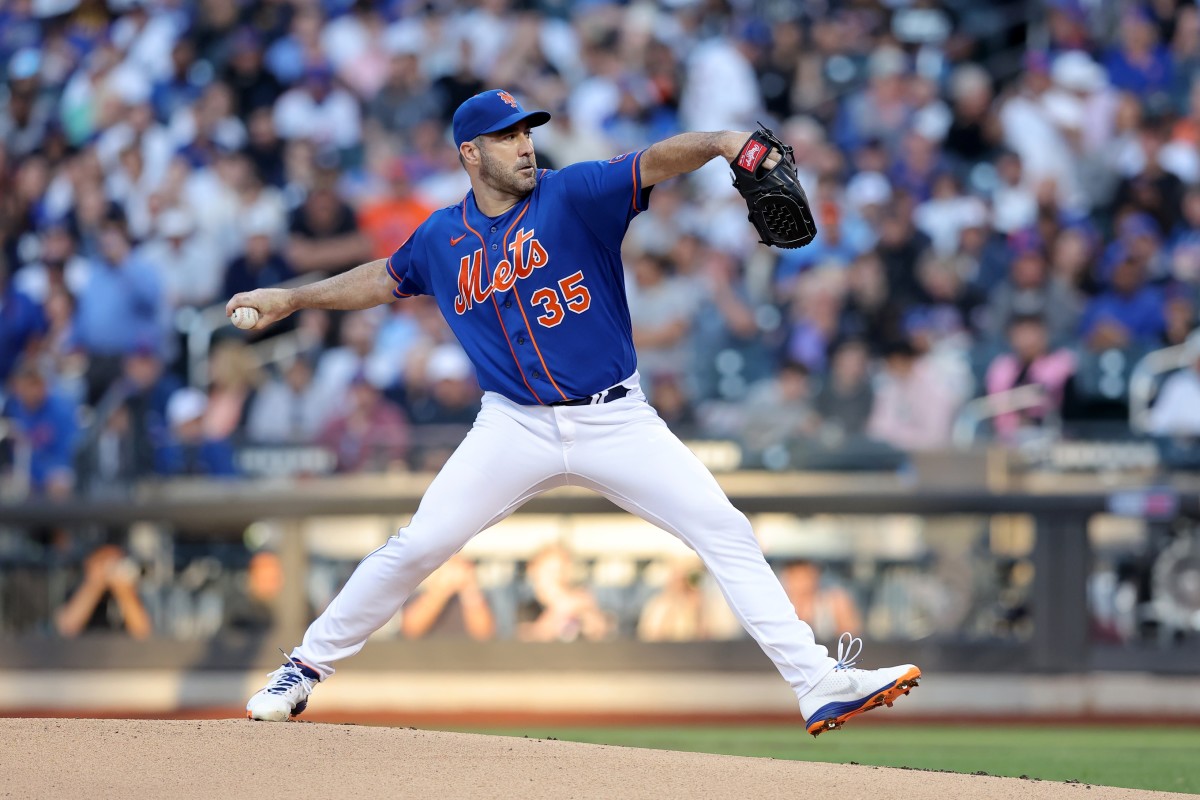How the Mets Became a $359 Million Mess

The Mets’ 74th game captured why, after almost half a season, the most expensive team in baseball gets only a 14.2% chance of reaching the playoffs, according to Baseball Reference. For only the second time in franchise history, the Mets on Wednesday gave up 10 runs (including two unearned runs), walked eight batters and threw two wild pitches in just eight innings in a road loss.
The 10–8 clunker in Houston has as its only comp in scattershot pitching a 19–10 defeat in Montreal by the 2004 Mets, losers of 91 games. These Mets are on pace to lose 88.
How could a team with a $359 million payroll possibly be this bad? Let us count the ways, based on where they stood after the game Wednesday.

1. Their pitching is inefficient.
The Mets have a mediocre offense and below-average defense, but you must start here when explaining them. Only the A’s throw fewer strikes.
Team | Percentage |
|---|---|
A’s | 61.6% |
Mets | 61.9% |
Rockies | 62.4% |
Brewers | 62.5% |
Nationals | 62.5% |
And that means the Mets don’t often enough get the biggest advantage in baseball: controlling count leverage. The average major league hitter bats .285 when he is ahead in the count and .201 when the pitcher is ahead. Mets pitchers rank with some awful teams when controlling count leverage.
Team | Percentage |
|---|---|
A’s | 29.3% |
Rockies | 29.2% |
Mets | 28.6% |
2. Their pitching is poor
Here’s where the Mets rank in key categories among MLB rotations:
Category | Amount | Rank |
|---|---|---|
Innings | 375.1 | 22 |
Quality Starts | 20 | 23 |
WHIP | 1.447 | 25 |
ERA | 5.01 | 26 |
K:BB | 2.17 | 27 |
The ERA for the Mets’ rotation has been more than five only twice in a full season: 2017, when New York lost 92 games, and 1962, when it lost 120.
3. The starting rotation is old.
The Mets planned a rotation around Justin Verlander, 40; Max Scherzer, 38; and Carlos Carrasco, 36. Only three teams had three qualified starters 36 and older, and those were so long ago they don’t apply: the 1945 Reds, ’45 Cubs and ’83 Angels.
The problem in today’s game is older pitchers need more rest. Mix in Kodai Senga, 30, who is accustomed to pitching once a week in Japan, and the Mets can’t lean on their starters to pitch every fifth day. In the rare times they try it, Mets starters are 3–5 with a 6.71 ERA.
Team | Starts |
|---|---|
Angels | 1 |
Astros | 10 |
Red Sox | 10 |
Padres | 11 |
Mets | 13 |
No first-place teams there. Unlike the Angels, the Mets’ specific problem is they don’t have an inventory of good young pitchers to support so much extra rest for the starters. New York is 19–15 when Verlander, Scherzer and Senga start and 15–25 with the six other starters they have tried.

4. They play from behind too often.
The Mets have been outscored 139–100 in the first three innings, having walked the most batters and given up more runs than all but three teams. With a league-average offense, New York has trouble making up early deficits.
5. They have few players in the sweet spot of their careers.
The Mets have only two qualified hitters and pitchers in their 20s: Francisco Lindor and Pete Alonso. That ties them for the fewest in baseball with the Yankees, Rockies and Tigers. Not a standout group. In a year of the pitch timer, more stolen bases and more ground to cover on defense without shifts, youth and athleticism have gained value.
Some of the biggest upstart teams this year are among the seven youngest teams: the Rays, Reds, Diamondbacks and Orioles. The Mets have used 24 players in their 30s, the most in baseball.
How bad is the Mets’ predicament? Don’t write them off yet. The past three full-season NL pennant winners all looked somewhat adrift through 74 games: the 2019 Nationals (36–38), ’21 Braves (35–39) and ’22 Phillies (39–35).
How many teams were as bad as the Mets 74 games into a season and rallied for a playoff spot? It’s a short list:
Team | Through 74 Games | Final |
|---|---|---|
1914 Braves | 32–41 | 94–59 |
1973 Mets | 32–41 | 82–79 |
1984 Royals | 34–40 | 84–78 |
2005 Astros | 34–40 | 89–73 |
2008 Dodgers | 34–40 | 84–78 |
2013 Dodgers | 32–42 | 92–70 |
2022 Mariners | 34–40 | 90–72 |
Let’s assume the barrier for a wild-card spot these days is 87 wins, the Phillies’ total last year as the final seed. Now you’re down to just four teams who pulled off such a massive turnaround.
What will it take for the Mets to make that kind of history? The 2019 Nationals remade their bullpen with trades, the ’21 Braves remade their outfield, the ’22 Phillies fired their manager and the ’22 Mariners went on a 14–0 run in July in which they won all six one-run games.
The Mets have a run in them. The question is whether it will be big enough. They should be getting José Quintana off the IL soon to help the rotation, but he’s 34 and doesn’t change the equation so much. Their most likely option is to continue to trust “the back of the baseball card,” as the cliché goes, and ride this group. Here’s the problem with that thinking, and it’s a problem the Yankees face as well: The game has turned to favor young players when it comes to health and performance.
Since the mound was lowered in 1969, the five worst seasons of hitting for players ages 31–35 happened in the past six seasons: 2018 (.244), ’20 (.245), ’21 (.244), ’22 (.242) and ’23 (.245). The Mets have given more plate appearances to players in that age bracket than every team but the Dodgers, Marlins and Angels and just ahead of the Yankees.
To reach 87 wins, the Mets must play at a .602 clip in their remaining 88 games (53–35). Possible? Sure. But here is the question owner Steve Cohen and GM Billy Eppler face: Do you trust this roster as constructed to play .600 baseball or do you shake it up next month with younger players?
